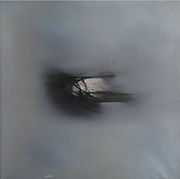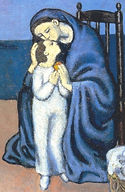top of page
Two | Curator's Notes
Galeria Paloma.Com is delighted and honoured to present its second exhibition and issue in Two, dedicated to the award-winning poet and one of the leading figures in contemporary Philippine literature, Dr. Marjorie Evasco.
This exhibition features poetry solely by Evasco, divided into two sections: the first section is an exhibition of paintings inspired by Evasco's poetry; the second section features a selection of her own ekphastic poetry on paintings that are the source of their inspiration.
The first section begins with Evasco's "Is It the Kingfisher?", one of two poems by Evasco that inspired Niño Hernandez's contribution to this exhibition and which frames the reflective piece, "A440." Hernandez is not only a visual artist but is also a musician (flutist, percussionist, and guitarist), and this facet of his artistic sensibility has informed "A440": "A" in "A440" refers to the note above middle C that serves as the general tuning standard for music. Hernandez explains that in tuning an instrument, "when the instrument hits the A note at 440HZ, it is in what one will call 'perfect pitch.' I read 'Is It the Kingfisher?' for several days, and at first, I thought the attitude was one of 'seeking.' However, as I became more familiar with the poem, I was more impressed with the thought that God was never needed to be sought--I felt that His presence had always been present," as was the overwhelming discovery accompanied by "the bolt of burning blue" in the poem: the discovery of an obvious answer. It is the timbre of the poem's spirit that Hernandez reflects in "A440." His use of the warmer tones to provide a counterpoint to the cool shades of blue shapes the painting even more, evoking an image of the lapis lazuli of water touching the coral and titan hues of the shore. "When I tune my instruments, and I find the perfect pitch, I not only hear or know I'm tune, but I feel like I'm in tune, just like tuning into the presence of God and the encompassing peace and synchronicity that accompanies it," he says.
Synchronicity also informs the theme of "4s and 8s," inspired by the meditative "Dancing a Spell." Hernandez took inspiration from the effortless partnership of music and dance and their harmonies interweaving in the poem, ignited by the artist's memory of a performance where the dancers moved in counts of 8 while the musicians, himself included, were keeping time in music's common time signature of 4--not quite at the same count and yet in sync. Is the single saffron stroke floating in the middle of the painting the fisher's boat? Is the blot of red a reflection of her sarong in water? The composition hearkens to the locus of a ripple, reverberating slowly outward from the center of the universe created by the first touch of a brush to a canvas, or a poet's pen to paper.
Two works by Phyllis Zaballero is also included in this collection. Both were completed in 1990 and were inspired by the poems "Trance at Toyabungkah" and "Acquainted With Lightning." Thoughtful and powerful, the paintings are rendered in Zaballero's signature bold hues, with the themes of each poem informing the painter's stokes and respective styles. In "Acquainted With Lightning," Zaballero's canvas is filled with the confidence of claps and cracks of paint, echoing Evasco's masterful use of imagery as the poet layers symbols with the crisp poise of lightning; in "Trance," Zaballero's strokes seem more fluid and languorous, effectively conjuring the meaningful quietude of Evasco's "Trance" and yet, as in the poem, conveys the secret of hidden fire.
Quietude and the warmth of an embrace is gently rendered in Bro. Hans Mapayo's painting inspired by "The Bells of San Giacomo." Warm and cool tones in a swirling composition balance the artwork, conveying the poem's loving maternal benediction and a measure of hope and deep faith.
The second section of this exhibition features a selection of Evasco's ekphrastic poetry. In this collection, included are the paintings of prominent artists in Philippine art history, namely, Fernando Zobel, Anita Magsaysay-Ho, and Juan Luna, as well as icons of the Western movement in modern art, Pablo Picasso and Rene Magritte. These pages contain excerpts from a speech given by Dr. Evasco at a FINEX (Financial Executives Institute of the Philippines) event several years ago and provides a wonderful peek into her artistic process as she created each of the ruminative and pure, powerful poems inspired by these works of art.
Marjorie Evasco is one of the leading figures in contemporary Philippine letters. Her work has garnered major awards including the Carlos Palanca Memorial Awards, National Book Awards from the Manila Critics' Circle, and accolades from Arinday (Silliman University), Gintong Aklat (Book Development Association of the Philippines) and Philippine Free Press for her poems and essays. Her poems have appeared in many important anthologies including The World Record: International Voices from Poetry Parnassus (Bloodaxe 2012), and Language for a New Century: Poems from Asia, the Middle East and Beyond (Norton 2009). She has also received various international fellowships; among them, a writing fellowship at the International Retreat for Writers in Hawthornden Castle, Midlothian, Scotland in 1991; a Rockefeller grant and residency in Villa Serbelloni, Bellagio, Italy in 1992; 10th Vancouver International Writers' Festival in 1997; International Writers' Program fellowship at the University of Iowa in 2002; University of Malaya Cultural Centre grant in Kuala Lumpur, Malaysia in 2003; the Wordfeast 1st Singapore International Literary Festival in 2004; the Man Hong Kong Literary Festival in 2006; the XVIII International Poetry Festival in Medellin, Colombia in 2008, and the 2010 Granada International Poetry Festival in Nicaragua.
She adds her most recent volume of poetry, "Fishes of Light (Peces de Luz)," written with Cuban poet Alex Fleites, to her books of poetry, "Dreamweavers," "Ochre Tones," and "Skin of Water." She has also won the National Book Award for Oral History, Biography, and Art for "Six Women Poets," "A Life Shaped by Music," "and "ANI: The Life and Art of Hermogena Borja Lungay," respectively. Her poems have been extensively published around the world, and have been translated into German, Spanish, Japanese, Chinese, Russian, Kannada, and Vietnamese. She was born on September 21, 1953 in Maribojoc, Bohol.
For inquiries on the artworks available for acquisition, please contact us by emailing inquiry@galeriapaloma.com or calling the exhibition manager at + 63.917.822.56.73. You may also contact us for copies of her books of poetry.
The next exhibition will coincide with a formal launch and exhibition of Galeria Paloma in Manila, Philippines. Be informed of this coming event by subscribing to GaleriaPaloma.Com at subscribe@galeriapaloma.com.
63
First Section:
Paintings inspired by the poetry of Marjorie Evasco
Niño Hernandez | A440
Marjorie Evasco | Is It the Kingfisher?
Nino Hernandez | 4s and 8s
Marjorie Evasco | Dancing a Spell
Phyllis Zaballero | Trance
Marjorie Evasco | Trance at Toyabungkah
Phyllis Zaballero | Acquainted With Lightning
Marjorie Evasco | Acquainted With Lightning
Bro. Hans Mapayo | The Bells of San Giacomo
Marjorie Evasco | The Bells of San Giacomo
Second Section:
The ekphrastic poetry of Marjorie Evasco
Fernando Zóbel | Tensión Luminosa
Marjorie Evasco | Tensión Luminosa
Anita Magsaysay-Ho | Women With Birds of Paradise
Marjorie Evasco | Birds of Paradise
Juan Luna | The Parisian Life
Marjorie Evasco | The Parisian Life
René Magritte | La Condition Humaine
Marjorie Evasco | La Condition Humaine
bottom of page









